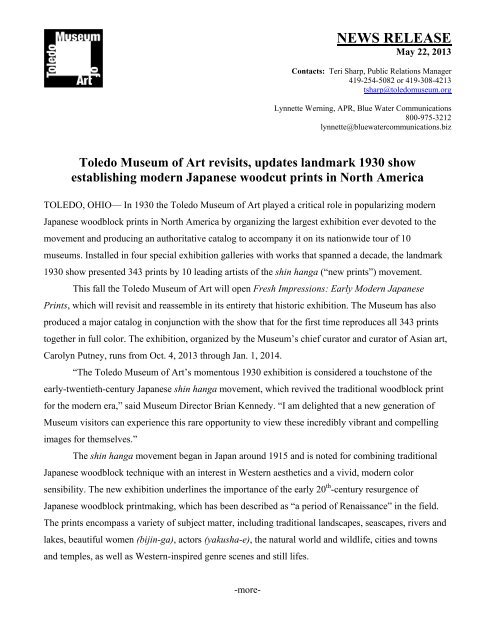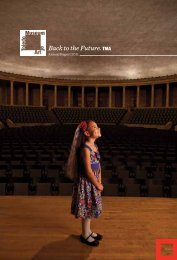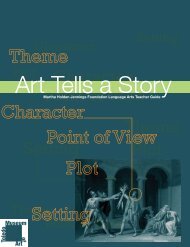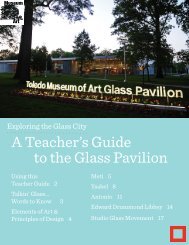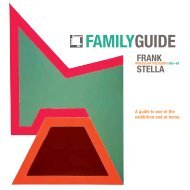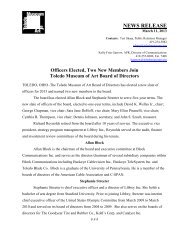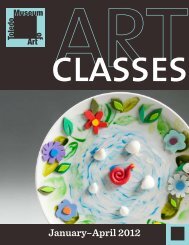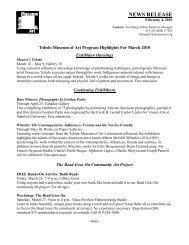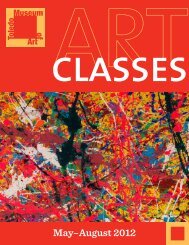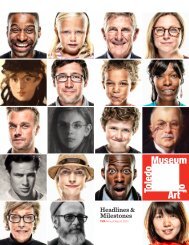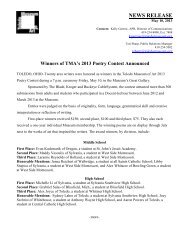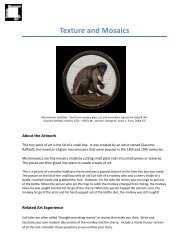NEWS RELEASE - The Toledo Museum of Art
NEWS RELEASE - The Toledo Museum of Art
NEWS RELEASE - The Toledo Museum of Art
Create successful ePaper yourself
Turn your PDF publications into a flip-book with our unique Google optimized e-Paper software.
<strong>NEWS</strong> <strong>RELEASE</strong><br />
May 22, 2013<br />
Contacts: Teri Sharp, Public Relations Manager<br />
419-254-5082 or 419-308-4213<br />
tsharp@toledomuseum.org<br />
Lynnette Werning, APR, Blue Water Communications<br />
800-975-3212<br />
lynnette@bluewatercommunications.biz<br />
<strong>Toledo</strong> <strong>Museum</strong> <strong>of</strong> <strong>Art</strong> revisits, updates landmark 1930 show<br />
establishing modern Japanese woodcut prints in North America<br />
TOLEDO, OHIO— In 1930 the <strong>Toledo</strong> <strong>Museum</strong> <strong>of</strong> <strong>Art</strong> played a critical role in popularizing modern<br />
Japanese woodblock prints in North America by organizing the largest exhibition ever devoted to the<br />
movement and producing an authoritative catalog to accompany it on its nationwide tour <strong>of</strong> 10<br />
museums. Installed in four special exhibition galleries with works that spanned a decade, the landmark<br />
1930 show presented 343 prints by 10 leading artists <strong>of</strong> the shin hanga (“new prints”) movement.<br />
This fall the <strong>Toledo</strong> <strong>Museum</strong> <strong>of</strong> <strong>Art</strong> will open Fresh Impressions: Early Modern Japanese<br />
Prints, which will revisit and reassemble in its entirety that historic exhibition. <strong>The</strong> <strong>Museum</strong> has also<br />
produced a major catalog in conjunction with the show that for the first time reproduces all 343 prints<br />
together in full color. <strong>The</strong> exhibition, organized by the <strong>Museum</strong>’s chief curator and curator <strong>of</strong> Asian art,<br />
Carolyn Putney, runs from Oct. 4, 2013 through Jan. 1, 2014.<br />
“<strong>The</strong> <strong>Toledo</strong> <strong>Museum</strong> <strong>of</strong> <strong>Art</strong>’s momentous 1930 exhibition is considered a touchstone <strong>of</strong> the<br />
early-twentieth-century Japanese shin hanga movement, which revived the traditional woodblock print<br />
for the modern era,” said <strong>Museum</strong> Director Brian Kennedy. “I am delighted that a new generation <strong>of</strong><br />
<strong>Museum</strong> visitors can experience this rare opportunity to view these incredibly vibrant and compelling<br />
images for themselves.”<br />
<strong>The</strong> shin hanga movement began in Japan around 1915 and is noted for combining traditional<br />
Japanese woodblock technique with an interest in Western aesthetics and a vivid, modern color<br />
sensibility. <strong>The</strong> new exhibition underlines the importance <strong>of</strong> the early 20 th -century resurgence <strong>of</strong><br />
Japanese woodblock printmaking, which has been described as “a period <strong>of</strong> Renaissance” in the field.<br />
<strong>The</strong> prints encompass a variety <strong>of</strong> subject matter, including traditional landscapes, seascapes, rivers and<br />
lakes, beautiful women (bijin-ga), actors (yakusha-e), the natural world and wildlife, cities and towns<br />
and temples, as well as Western-inspired genre scenes and still lifes.<br />
-more-
Fresh Impressions 2–<br />
<strong>The</strong> 10 artists in the exhibition are Hashiguchi Goyō (1880–1921), Itō Shinsui (1898–1972),<br />
Kawase Hasui (1883–1957), Miki Suizan (1887–1957), Natori Shunsen (1886–1960), Oda Kazuma<br />
(1882–1956), Ohara Shōson, also known as Ohara Kōson (1877–1945), Yamamura Toyonari, also<br />
known as Yamamura Kōka (1885–1942), Hiroshi Yoshida (1876–1950) and Yoshikawa Kanpo (1894–<br />
1979).<br />
All but five <strong>of</strong> the 343 prints are now in the <strong>Museum</strong>’s collection. Most <strong>of</strong> these were purchased<br />
around the time <strong>of</strong> the original show and donated to the <strong>Museum</strong> in 1939 by local businessman and print<br />
collector Hubert D. Bennett. (<strong>The</strong> <strong>Museum</strong> is borrowing the additional five prints.) <strong>The</strong> <strong>Toledo</strong> <strong>Museum</strong><br />
<strong>of</strong> <strong>Art</strong>’s collection <strong>of</strong> shin hanga is considered to be one <strong>of</strong> the finest in any museum in the country. <strong>The</strong><br />
prints have only rarely been out <strong>of</strong> storage since the 1930s and as a result are in pristine condition.<br />
In addition to the 343 woodblock prints, the exhibition will present companion objects depicted<br />
in the prints—such as kimonos, netsuke and samurai swords and armor—not included in the original<br />
1930 show. A companion exhibition, Ebb and Flow, in the Works on Paper Gallery, covers the period<br />
from the 1930s to the present and explores the global influence <strong>of</strong> these modern Japanese printmakers.<br />
Shin hanga was introduced to the American public in the 1920s through several smaller<br />
exhibitions organized to benefit artists affected by the great Kantō earthquake <strong>of</strong> 1923. But it was not<br />
until the <strong>Toledo</strong> <strong>Museum</strong> <strong>of</strong> <strong>Art</strong>’s 1930 show, A Special Exhibition <strong>of</strong> Modern Japanese Prints—coorganized<br />
by <strong>Toledo</strong> curators J. <strong>Art</strong>hur MacLean (1879–1964) and Dorothy L. Blair (1890–1989), in<br />
collaboration with shin hanga artist Yoshida—that the movement’s scope was fully grasped and<br />
examined. <strong>The</strong> original catalog, which was fully illustrated in black-and-white and featured artist<br />
biographies, signatures and seals, became an invaluable resource on the work <strong>of</strong> modern Japanese<br />
printmakers for scholars and enthusiasts; it was reprinted twice.<br />
Blair, the subject <strong>of</strong> Putney’s essay in the new catalog, was a pioneering authority on Asian art<br />
and culture in a field dominated by men. In 1927 she spent a year studying in Japan at Kyoto Imperial<br />
University—the first woman and first foreigner accorded that privileged status. She became assistant<br />
curator at the <strong>Toledo</strong> <strong>Museum</strong> <strong>of</strong> <strong>Art</strong> in 1928, after stints at several other noted museums, including the<br />
Cleveland <strong>Museum</strong> <strong>of</strong> <strong>Art</strong> and the <strong>Art</strong> Institute <strong>of</strong> Chicago.<br />
<strong>The</strong> 352-page book accompanying Fresh Impressions, with essays by Putney, scholars Kendall<br />
H. Brown and Koyama Shukō and artist Paul Binnie, was published with the assistance <strong>of</strong> <strong>The</strong> Andrew<br />
W. Mellon Foundation and the E. Rhodes and Leona B. Carpenter Foundation.<br />
-more-
Fresh Impressions 3–<br />
<strong>The</strong> exhibition was made possible in part by the E. Rhodes and Leona B. Carpenter Foundation.<br />
Admission to the exhibition and to the <strong>Museum</strong> is free. <strong>The</strong> companion catalog will be available<br />
for purchase through the <strong>Museum</strong> Store and online at toledomuseum.org in early Ocotber.<br />
# # #<br />
Note: For more information contact Teri Sharp at 419-254-5082 or tsharp@toledomuseum.org, or<br />
Lynnette Werning at 800-975-3212 or lynnette@bluewatercommunications.biz<br />
# # #<br />
<strong>The</strong> <strong>Toledo</strong> <strong>Museum</strong> <strong>of</strong> <strong>Art</strong> is a nonpr<strong>of</strong>it arts institution funded through individual donations, foundation grants, corporate<br />
sponsorships, and investments. <strong>The</strong> Ohio <strong>Art</strong>s Council helps fund programs at the <strong>Toledo</strong> <strong>Museum</strong> <strong>of</strong> <strong>Art</strong> through a<br />
sustainability grant program that encourages economic growth, educational excellence and cultural enrichment for all<br />
Ohioans. Glass Pavilion® and <strong>Toledo</strong> <strong>Museum</strong> <strong>of</strong> <strong>Art</strong> Glass Pavilion® are registered service marks.<br />
Admission to the <strong>Museum</strong> is free. <strong>The</strong> <strong>Museum</strong> is open Tuesday, Wednesday, Thursday, 10 a.m. to 4 p.m.; Friday, 10 a.m.<br />
to 10 p.m.; Saturday, 10 a.m. to 6 p.m.; Sunday, Noon to 6 p.m.; closed Mondays and major holidays. Friday evening hours<br />
are made possible by Fifth Third Bank.<br />
<strong>The</strong> <strong>Museum</strong> is located at 2445 Monroe Street at Scottwood Avenue, just west <strong>of</strong> the downtown business district and one<br />
block <strong>of</strong>f I-75 with exit designations posted. For general information, visitors can call 419-255-8000 or 800-644-6862, or<br />
visit toledomuseum.org.


